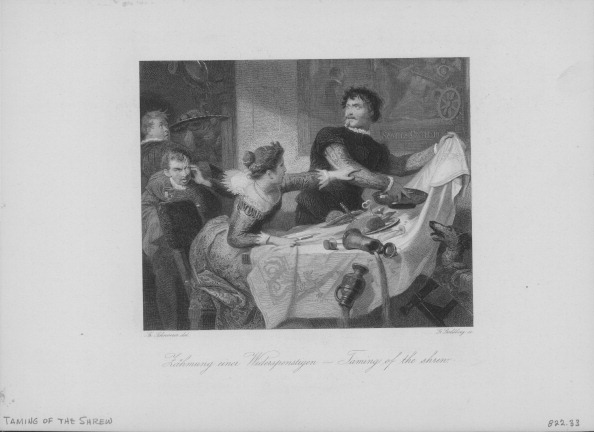Shakespeare’s “The Taming of the Shrew,” the story of a man’s choosing a loud and troublesome but rich and beautiful girl for his wife and “taming” her destructive misbehavior, has been for centuries a favorite of audiences. But it has now fallen on hard times. This happened when feminism was converted from the idealism of equal rights for women into resentment for the supposed perennial oppression of women by men.
As a result of that intellectual wind, those who did still want to produce the play would doctor the ending by going against the grain of the text to show Katherine making a mere show of obedience. She would deliver her final speech with ironic winks to the audience, suggesting that she had learned to pretend to be obedient to Petruchio but, in reality, was secretly manipulating him. The whole idea of “taming” her was thus turned into farce, and the resentful in the audience were given a satisfying inversion of power roles to take home with them to justify their resentment.
The unfortunate byproduct of that kind of production was that the audience was robbed of the possibility of experiencing the great reversal that Shakespeare actually dramatized in the play. The reversal I mean is not the mere subduing of Katherine’s will under the power of Petruchio and her consequent surrender to his government. Shakespeare meant that power play to be not a goal of Petruchio but merely a tool to achieve what he really wanted. What Petruchio really wanted was what was best for both of them: harmony, a happy union of man and wife. In short, love.
Portraying a Higher Goal
How does Shakespeare portray the achievement of that higher goal? In three ways.
First, Shakespeare doesn’t have Petruchio simply cudgel Katherine into obedience. (In the old joke that was one of the play’s sources, a husband wrapped his wife in a mule’s skin and beat her with a stick.)
Instead, Petruchio shows Katherine what it looks like when someone is being irrational, as was Katherine’s habit. His version of her irrational willfulness produces chaos, causes her to suffer, to go hungry and sleepless. It’s how every parent must train a self-damaging, willful child: “Here is what your behavior looks like and leads to. Do you want that?”
Second, Shakespeare has Petruchio enact this irrationality as if for Katherine’s own sake. He tosses away the food she hungers for because, he says, it’s not cooked as well as she deserves; rips apart the beautiful tailor’s gown as not good enough for her; creates havoc in the bedroom, all “in reverend care of her.” He “kills her in her own humor” by seeming to “kill her with kindness,” countering her selfish willfulness with an equal but opposite selfless willfulness.
The irony, for the audience, is that though Petruchio is creating actual havoc, keeping Katherine miserable in the name of serving her, in reality, he is doing this for her sake. Because in fact, her only path to peace and happiness is the giving up of her own selfish will. Once she has done that, there is no more power struggle; they can live happily ever after.
Rejection of Power Struggle
Finally, Shakespeare dramatizes the achievement of the goal of love with a wonderful rejection of the power-struggle image of marriage in favor of an image of mutual love. It comes after Katherine is fully subdued to Petruchio’s will. She has already called the sun the moon and an old man young because her husband commands her to do so.
When the other wives refuse to come at their husbands’ call, Petruchio commands Katherine to force the other wives to obey. She does so and then gives her great speech about the hierarchy of duty and the division of labor that must prevail in marriage at its best. The husband is stronger than the wife, but his duty is to use his strength not to oppress her but to defend and care for her, just as her duty is to care for him as best she can and to be grateful.
But here’s Shakespeare’s kicker. At the end of the speech, Katherine offers to place her hand beneath Petruchio’s foot as a symbol of her true obedience to him. And what does Shakespeare have Petruchio do? Step on her hand and crow “Ha! I’ve won! I’m stronger than you and will now oppress you freely!”? No. He says: “Why there’s a wench! Come on, and kiss me, Kate.” (“Wench” is a term, and “Kate” a nickname, of endearment.)
What does that kiss mean? Not the triumph of power over weakness, but the joy of mutual love. Now that both members of the pair are in their right relation to one another in the hierarchy created for their mutual benefit, neither one combating against the other in willfulness but each committed to the other’s good—now they can live happily ever after.
Isn’t this a better image of marriage than the confrontation between two strugglers for power?
Gideon Rappaport has a doctorate in English and American Literature with specialization in Shakespeare. He has taught literature, writing, and Shakespeare at all levels and works as a theatrical dramaturge. He podcasts at Appreciating Shakespeare with Doctor Rap (AppreciatingShakespeare.Buzzsprout.com) and on YouTube, where he also has video lectures at Shakespeare’s Real Take.













